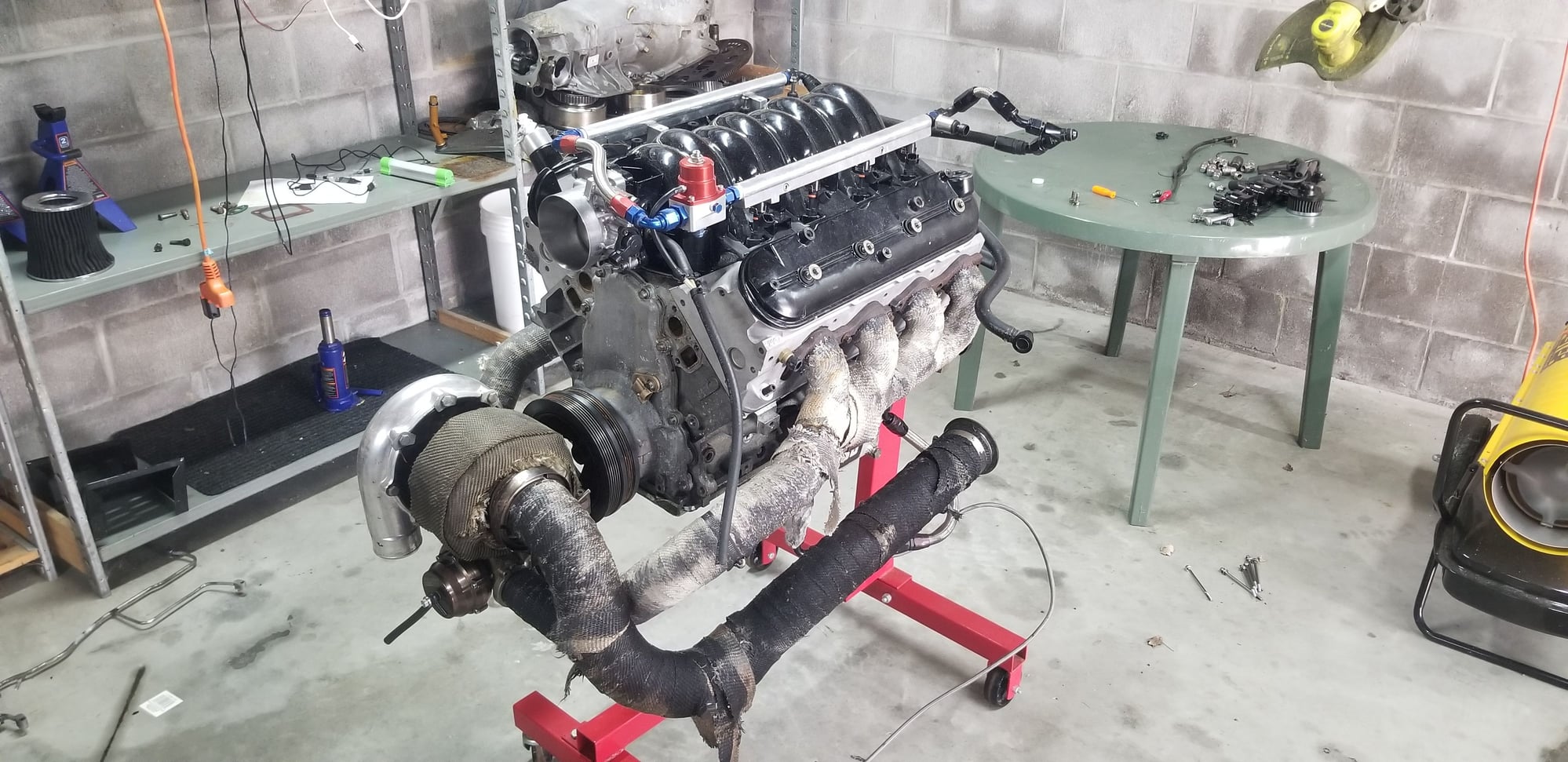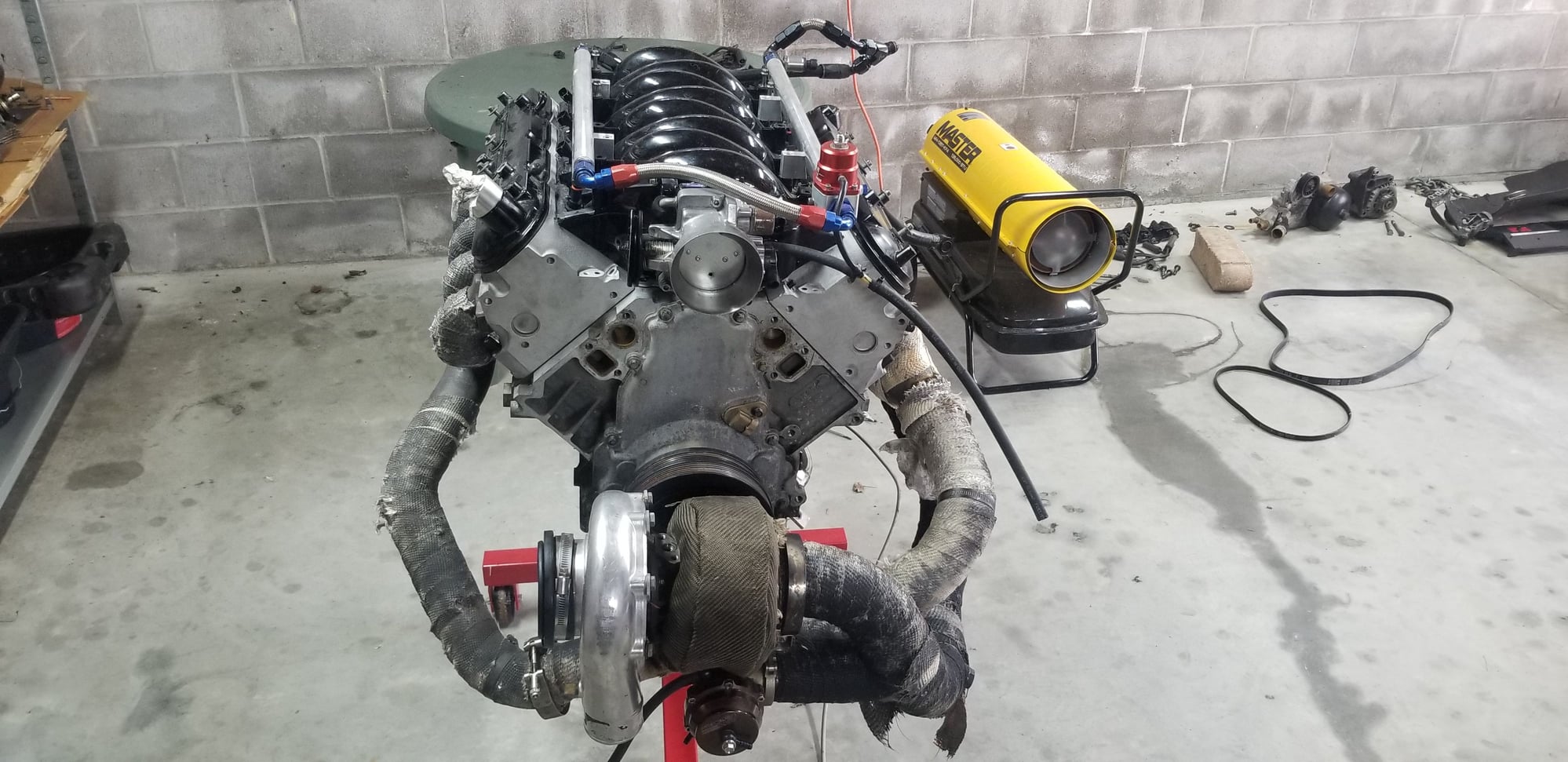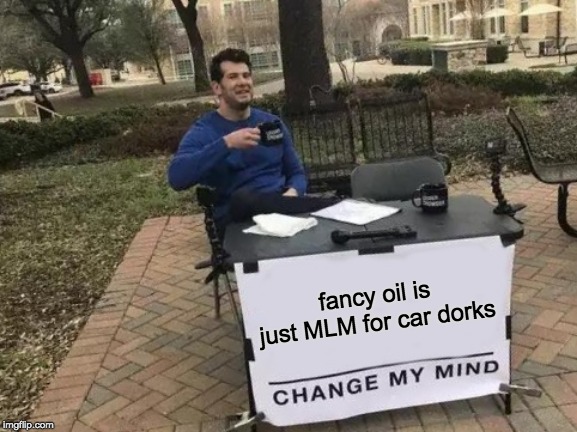Let's settle this oil pressure debate.....
#41
Most cases would be sufficient with a 30 grade. Even boosted applications (up to a point), I wouldn't advice going up to a 40 or 50 grade. I would advise a superior 30 grade. Oils like Driven LS30 5w-30, Red Line HP 5w-30, HPL Bad *** 5w-30, and LAT Racing 5w-30 put Rotella, Delo, and Delvac 15w-40 to shame in terms of oxidative stability, thermal stability, shear stability, aeration inhibition, and friction reduction.
Diesel oil can certainly still get the job done, but it's leaving a narrower margin for error. A drag racing engine that operates at <200*F with only a short burst at WOT probably won't see much negative effects from diesel oil as the run is over before the effects of aeration start to show. Put that same oil in a NASCAR cup engine, where the oil pump inlet temps are 280*F with bearing temperatures >350*F, and it wouldn't last 2 laps around Daytona. The drag racing engine would still benefit from a superior, lower grade oil as the lower friction, lower pressure-viscosity coefficient, and lower oil pressure all translates into quicker ET through free'd up power, everything else equal.
Diesel oil can certainly still get the job done, but it's leaving a narrower margin for error. A drag racing engine that operates at <200*F with only a short burst at WOT probably won't see much negative effects from diesel oil as the run is over before the effects of aeration start to show. Put that same oil in a NASCAR cup engine, where the oil pump inlet temps are 280*F with bearing temperatures >350*F, and it wouldn't last 2 laps around Daytona. The drag racing engine would still benefit from a superior, lower grade oil as the lower friction, lower pressure-viscosity coefficient, and lower oil pressure all translates into quicker ET through free'd up power, everything else equal.
For your average turbocharged 150-200k mile engine, the benefits of 15w-40 or 20w-50 aren't really about lubrication.
The thicker oil won't seep past worn rings or valve stem seals as easily. Any oil that enters the cylinder increases the risk of detonation. Even if the oil itself doesn't cause detonation, the build-up left behind from it will.
#42
Excellent post and great info GameOva,
This helps bolster my decision to run a standard volume/pressure pump that will receive internal porting and perhaps a little spring shim.
No one has still been able to confirm whether a HV/HP pump is needed with an oil cooler, I don't think it is since I've been running one with a stock pump for three years now.
This helps bolster my decision to run a standard volume/pressure pump that will receive internal porting and perhaps a little spring shim.
No one has still been able to confirm whether a HV/HP pump is needed with an oil cooler, I don't think it is since I've been running one with a stock pump for three years now.
#44
This right here, is exactly what this thread is trying to do away with. Anyone can come in here with a generalization and seem smart, but that is exactly what prevents proper and detailed information from being shared.
OP Provided a baseline claim, and backed it with pictures.
Will this be true for everyone? Of course not - but at some point as a community, we have to try to reach SOME depth of "absolute" - as best as we can.
Only thing missing from OP is exact bearing clearances.
#45
5w-30 is perfectly fine for a fresh rebuild.
For your average turbocharged 150-200k mile engine, the benefits of 15w-40 or 20w-50 aren't really about lubrication.
The thicker oil won't seep past worn rings or valve stem seals as easily. Any oil that enters the cylinder increases the risk of detonation. Even if the oil itself doesn't cause detonation, the build-up left behind from it will.
For your average turbocharged 150-200k mile engine, the benefits of 15w-40 or 20w-50 aren't really about lubrication.
The thicker oil won't seep past worn rings or valve stem seals as easily. Any oil that enters the cylinder increases the risk of detonation. Even if the oil itself doesn't cause detonation, the build-up left behind from it will.
Oil transport pas the rings can increase with a higher viscosity oil as the thicker oil film means more oil transport past the rings. It also means increased hydrodynamic friction imparted on the rings and pistons. Oils with higher surface affinity will also tend to have higher oil consumption past the rings regardless of viscosity.
#46
I just pulled my engine apart and it had 25 psi of pressure when cold and 25-30 hot. The front main has a groove in it .060" deep and every main is absolutely smoked except for the 4th one back from the front. Had 1 rod bearing that was going bad, but the rest were perfect. There is bearing material all throughout the engine, so everything is getting replaced.
Thar was with 5w-30 oil.
Thar was with 5w-30 oil.
#48
Uhhhh, with all "due" respect:
This right here, is exactly what this thread is trying to do away with. Anyone can come in here with a generalization and seem smart, but that is exactly what prevents proper and detailed information from being shared.
OP Provided a baseline claim, and backed it with pictures.
Will this be true for everyone? Of course not - but at some point as a community, we have to try to reach SOME depth of "absolute" - as best as we can.
Only thing missing from OP is exact bearing clearances.
This right here, is exactly what this thread is trying to do away with. Anyone can come in here with a generalization and seem smart, but that is exactly what prevents proper and detailed information from being shared.
OP Provided a baseline claim, and backed it with pictures.
Will this be true for everyone? Of course not - but at some point as a community, we have to try to reach SOME depth of "absolute" - as best as we can.
Only thing missing from OP is exact bearing clearances.
#51
Every one of my engines have <20 psi oil pressure at hot idle, and I haven't gotten back a single oil related failure. There was one idiot recently who thought SuperTech was as good as Red Line because he watched a Youtube video, and got mad when I denied the warranty on his wiped cam lobe. That was his error though. A couple of those engines have over 100,000 hard driven miles on them.
#52
Uhhhh, with all "due" respect:
This right here, is exactly what this thread is trying to do away with. Anyone can come in here with a generalization and seem smart, but that is exactly what prevents proper and detailed information from being shared.
OP Provided a baseline claim, and backed it with pictures.
Will this be true for everyone? Of course not - but at some point as a community, we have to try to reach SOME depth of "absolute" - as best as we can.
Only thing missing from OP is exact bearing clearances.
This right here, is exactly what this thread is trying to do away with. Anyone can come in here with a generalization and seem smart, but that is exactly what prevents proper and detailed information from being shared.
OP Provided a baseline claim, and backed it with pictures.
Will this be true for everyone? Of course not - but at some point as a community, we have to try to reach SOME depth of "absolute" - as best as we can.
Only thing missing from OP is exact bearing clearances.
Now for purpose built, high end, particular types of builds....yes, listen to the builder. But for 99.99% of engines out there......if it has rule-of-thumb pressure just drive it.
#53
I was about to reply to his post, but when I seen yours, I decided that I couldn't have said it better. It's weird how you can have absolute hardcore evidence, backed with pics of your OWN SETUP (no hearsay here), and there will still be those who attempt to refute. This is the very reason I took pics of my bottom end, and even went so far as to provide pics of the mechanical gauge in the car with it running.
So I'm just saying......its not a bid deal with basic street-strip engines.
Its like oil weights to use.........everyone uses different weights.....everyones engines run forever.....it just doesn't matter for basic street-strip engines.
#54
There are downsides to having too much oil pressure. The main one being aeration. The higher the oil pressure, the greater the capacity for entrained air, and shorter time to release that air as the oil has less dwell time in the sump. If the oil gets severely aerated and encounters a low pressure area in the system (ie: bearings), the air will release, displacing the oil, and you get cavitation in the bearing. The aeration has to get very bad for this to occur, but I have seen it. Due to this, I always advise a larger oil pan capacity when using a HV or HP pump to increase the oil's dwell time in the pan. If I encounter a situation where higher volume is actually needed, I'm usually ready to go dry sump by that point anyway.
A lesser issue is loss of power trying to pump and maintain the higher volume/pressure.
A lesser issue is loss of power trying to pump and maintain the higher volume/pressure.
#55
My 100k mile LS1 in the vette still has 38psi hot idle. prob 300 passes shifting at 6700.
There is never any sparkle in the oil. I run Mobil 1 extended life 10W30
When I modded it 7 years ago I used the GM performance pump from Tooley.
Nova has been an adventure as I've been stuck in the glitter oil dilemma for the last month.
When the L33 had stock bottom end, I simply disassembled, cleaned, re-gapped rings for boost and reassembled.
After 3 years, max of 19 psi boost, took it apart and all was good. Some shiny spots on mains 2 and 4, typical for boosted deals. Had no clue what the stock bearing clearances were. Should have checked for info. But I didn't.
I decided to amp the thing up and wanted no worries. LJMS rod and piston combo. Had my machinist balance and assemble the short block. Rods were .0025" and the mains were .0019 to .0021". Alum block so the mains will grow. He did align hone it.
Lost the thrust... ...
Clevite 77 and the bearings looked just like GameOva pics. Builder said yuch ...****'s moving around. Max boost was 22.
Shiny spots show metal to metal. Uneven wear shows crank flex.
So fast forward. New forged crank, new high zoot Manley rods. Rods and mains now at .0025". 9 passes, all at 24 psi, metal in the oil. Thrust is still good! King bearings. A little metal in the filter. A lot of piston coating in the filter. Wiseco just missed it on their skirt coating. Half was gone prev assembly.
Sadly, we can't X-ray the engine in the car and see what's wearing. That glitter comes from something. Correct?
BTW, oil pressure still solid.
FWIW I took apart a rat motor recently been abused for a few years and lost a roller lifter. It also had Clevite 77 bearings, but they were coated. Couldn't tell they were even run... ..
I'm going to reassemble the valvetrain and just run mine.
So oil pressure. I used a new cam retainer (easy spot to leak) and went for the fancy Sac City barbell. Even with larger main bearing clearance, oil pressure went up. I run 10W30 Red Line oil. Same GM perf pump I have in the vette.
Point being, there are many "leaks" that can attribute to oil pressure. 20psi hot idle isn't normal, but it works.
Good info man ,appreciate it. As far as settling anything... ..
Ron
There is never any sparkle in the oil. I run Mobil 1 extended life 10W30
When I modded it 7 years ago I used the GM performance pump from Tooley.
Nova has been an adventure as I've been stuck in the glitter oil dilemma for the last month.
When the L33 had stock bottom end, I simply disassembled, cleaned, re-gapped rings for boost and reassembled.
After 3 years, max of 19 psi boost, took it apart and all was good. Some shiny spots on mains 2 and 4, typical for boosted deals. Had no clue what the stock bearing clearances were. Should have checked for info. But I didn't.
I decided to amp the thing up and wanted no worries. LJMS rod and piston combo. Had my machinist balance and assemble the short block. Rods were .0025" and the mains were .0019 to .0021". Alum block so the mains will grow. He did align hone it.
Lost the thrust... ...
Clevite 77 and the bearings looked just like GameOva pics. Builder said yuch ...****'s moving around. Max boost was 22.
Shiny spots show metal to metal. Uneven wear shows crank flex.
So fast forward. New forged crank, new high zoot Manley rods. Rods and mains now at .0025". 9 passes, all at 24 psi, metal in the oil. Thrust is still good! King bearings. A little metal in the filter. A lot of piston coating in the filter. Wiseco just missed it on their skirt coating. Half was gone prev assembly.
Sadly, we can't X-ray the engine in the car and see what's wearing. That glitter comes from something. Correct?
BTW, oil pressure still solid.
FWIW I took apart a rat motor recently been abused for a few years and lost a roller lifter. It also had Clevite 77 bearings, but they were coated. Couldn't tell they were even run... ..
I'm going to reassemble the valvetrain and just run mine.
So oil pressure. I used a new cam retainer (easy spot to leak) and went for the fancy Sac City barbell. Even with larger main bearing clearance, oil pressure went up. I run 10W30 Red Line oil. Same GM perf pump I have in the vette.
Point being, there are many "leaks" that can attribute to oil pressure. 20psi hot idle isn't normal, but it works.
Good info man ,appreciate it. As far as settling anything... ..
Ron
#58








 don't forget the NA motor better than boost for anything less than 1000hp
don't forget the NA motor better than boost for anything less than 1000hp 